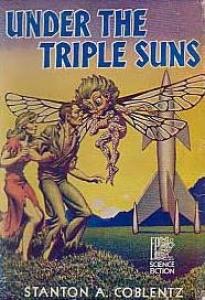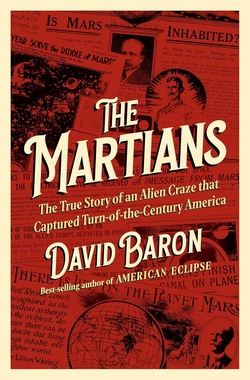Centauri Dreams
Imagining and Planning Interstellar Exploration
Searching for Exoplanet Rings
Not long ago we looked at the discovery of what appears to be a disk orbiting the huge gas giant J1407b (see Enormous Ring System Hints of Exomoons). The example of Saturn is one thing that makes us wonder whether rings might exist around exoplanets, but of course in our own Solar System we also have Jupiter, Uranus and Neptune as hosts of ring systems of different sizes. In the case of J1407b, we’re not strictly sure that the object is a planet. If it’s actually a brown dwarf, we might be observing a protoplanetary disk in a young system.
I’m not surprised when it comes to looking for ring systems around exoplanets that David Kipping (Harvard-Smithsonian Center for Astrophysics) should be in the mix. Working with Jorge Zuluaga (University of Antioquia) and two of their students, Kipping is co-author of a paper discussing how we might identify what are now being called ‘exorings.’ As illustrated in the figure below, an exoplanet’s transit signature is a key, taking advantage of the fact that a planet with a ring system will produce a longer, deeper transit than the same planet without any rings.
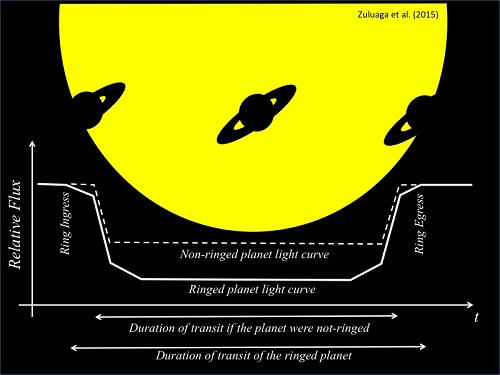
Image: Schematic representation of the transit of a ringed planet in front of its star. When compared with the light curve of an non-ringed analogue (dashed line) the transit of a ringed planet is deeper (the relative flux diminishes by a larger fraction) and longer. Credit: Jorge Zuluaga/David Kipping.
The trick here is to separate the effect of a larger planet seen in transit from a smaller world with a ring system. The paper explains that in transit studies, objects that appear larger than expected are often classed as false positives, a category that the authors think merits a careful look in case what is being rejected is actually a planet with a ring system. From the paper:
The transits of a Saturn-like ringed-planet are up to ?3 times deeper than that expected for a spherical non-ringed one. These deep transits will be interpreted as produced by a planet ?1.7 times larger. Additionally, if independent estimations of its mass were also available, the density of the planet will be underestimated by a factor of ?5. Thus, instead of measuring Saturn’s density ?0.7 g/cm3 , this planet would seem to have an anomalously low density of ?0.14 g/cm3 . Even under more realistic orientations (cosiR ? 0.2) the observed radius will be ?20% larger and the estimated density almost a half of the real one.
It is conceivable, then, that some ‘false-positive’ transits conceal a population of planets with rings.
An effect based on asterodensity profiling that the authors call the ‘photo-ring’ effect also comes into play. Here we examine the transit depth and its duration. The first is related to the size of the star, while the second depends on orbital velocity and the mass of the star. Out of this information we can estimate the star’s density, a result that can be compared with independent density calculations from methods like asteroseismology or the transits of other planetary companions to see if the results coincide. A discrepancy may be telling: The presence of rings around the transiting world, the authors argue, leads to an underestimation of stellar density.
Interestingly, the two effects we seek (anomalous transit depths and photo-ring effect) are complementary with respect to the orientation of the ring plane. For large inclinations and obliquities (face-on rings), the effect on transit depths is significant whilst the photo-ring effect is negligible. Alternatively, if rings have relatively low obliquities (edge-on rings), then the photo-ring effect will be considerable but the depth anomaly small.
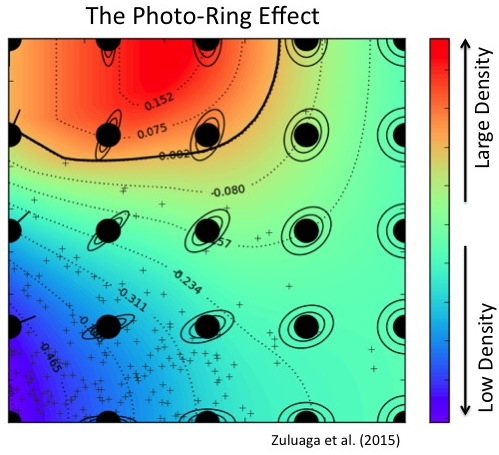
Image: Magnitude of the so-called Photo-ring effect predicted by Zuluaga, Kipping et al., at different projected inclinations and tilts (small “saturns”). Credit: Jorge Zuluaga/David Kipping.
The strategies that emerge from this study are thus complementary. We can look for already confirmed transiting planets that appear to have anomalously low densities for further study. We can also reinvestigate our catalog of false-positives due to anomalously large transit depths to see if any of these could mask a ringed planet’s signature. Finally, we can search for transit signals that show the ‘photo-ring’ effect, looking for discrepancies in density calculations.
None of this implies that studying transit lightcurves itself does not remain significant:
We stress that the method presented here is complementary to the methods developed to discover exorings through detailed light curve modelling (Barnes & Fortney 2004; Ohta et al. 2009; Tusnski & Valio 2011). As explained earlier, the role of these methods will be very important once a suitable list of potential exoring candidates [is] found. It is, however, also important to note the great value of light curve models developed under the guiding principle of computational efficiency (semianalytical formulae, efficient numerical procedures, etc.), such as the basic models presented here.
We thus have a relatively straightforward technique for surveying our transiting planet catalogs for ringed-planet candidates, looking for that subset that can be subjected to more detailed lightcurve analysis. The paper is Zuluaga et al., “A Novel Method for Identifying Exoplanetary Rings,” accepted for publication at Astrophysical Journal Letters (preprint).

Dawn Orbits Ceres
I spent the morning working on an interesting paper about detecting ‘exorings’ — ring systems like Saturn’s around exoplanets — while switching back and forth to Twitter and various Web sources to follow events as the Dawn spacecraft became gravitationally captured by Ceres. I have problems with so-called ‘multi-tasking,’ which at least in my case means I do two things at once, performing each task less effectively than if I were tackling them separately. Fortunately, I have all weekend to tune up the exorings story, and I put it temporarily aside to work on Dawn’s historic arrival.
Congratulations to the entire Dawn team on the continuance of this splendid mission. We have much to look forward to as observations proceed and the orbit stabilizes. Similarly, we have the almost immediate prospect of following New Horizons in to Pluto/Charon, another case of a previously blurry object taking on breathtaking resolution as the days pass. The bounty of 2015 then opens into an uncertain future when it comes to exploring the outer system, but we can hope that the New Horizons extended mission will happen as anticipated and investigate a Kuiper Belt Object. We can also hope that the European Space Agency proceeds with its Jupiter Icy Moons Explorer without what would have been the NASA side of the mission.
Regarding Dawn, remember that the benefits of ion propulsion have never been more obvious thanks to this mission. The first spacecraft to reach orbit around a dwarf planet (at approximately 1239 UTC today), Dawn is also the first spacecraft to orbit more than one target, having explored the asteroid Vesta from 2011 to 2012 before moving on to its current location. That gives us quality data time at the two most massive asteroids in the main belt that stretches between Mars and Jupiter.
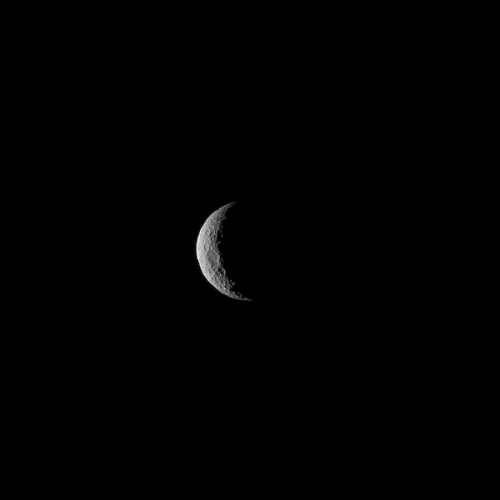
The just released image above was taken on March 1, before orbital insertion and before Dawn swung behind Ceres. The view is just a teaser for the scenery we’re going to be looking at as the spacecraft begins its orbital investigations. It took seven and a half years to get here (and 4.9 billion kilometers along the route), but we now have a healthy spacecraft at its target. This image was taken about 48,000 kilometers out, at a Sun-Ceres-spacecraft angle (phase angle) of 123 degrees. The image scale here is 2.9 kilometers per pixel. We’ll get new imagery in April as Dawn moves back around the near side of Ceres with respect to the Sun.

Planet in a Quadruple Star System
Planets in multiple star systems intrigue us particularly when we try to imagine the view from the surface. Call it the ‘Tatooine Effect,’ made to order for visual effects specialists and cinematographers. But planets like these also raise interesting issues. Lewis Roberts (JPL) and colleagues have just published a new study of the 30 Ari system, demonstrating that it is a quadruple star system with a gas giant of about four times the mass of Jupiter in a 335 day orbit around its primary star.
We already knew about the planet in the 30 Ari system. What’s new is the discovery of the additional star. At 23 AU from the planet, the newly discovered fourth star would seem to be a factor in the orbital dynamics of the gas giant, but just what effects it has remain to be studied. The paper, which also reports the detection of a stellar companion to the exoplanet host system HD 2638, notes that 30 Ari is the second quadruple system known to host an exoplanet. And interestingly, both HD 2638 BC and 30 Ari BC have projected separations of less than 30 AU, so that the stellar companions may play a key role in the evolution of the exoplanets’ orbits.
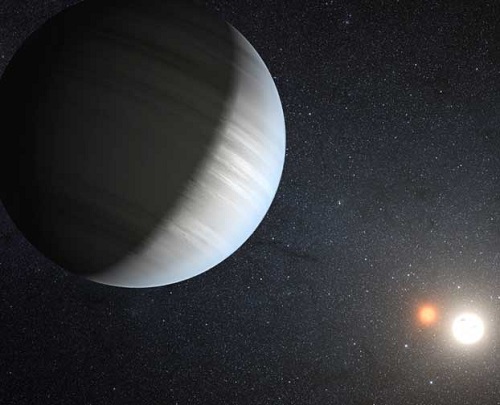
Image: A gas giant orbiting a binary star. How planets interact with their primary and other stars in multiple-star systems like these is a question that will demand orbital computations over a long span of observation. Credit: NASA, E. Schwamb.
According to this news release from the University of Hawaii’s Institute for Astronomy, the view from the surface of the 30 Ari planet (or, let’s say, a moon around it) would involve the primary star and two other stars bright enough to be visible in daylight. One of the bright ‘stars’ would actually be a binary system if examined in a telescope. The other known planet in a quadruple system is Ph1b in a system designated KIC 4862625, from which a different view would emerge. Ph1b is on a circumbinary orbit, a giant planet of between 20 and 55 Earth masses orbiting an eclipsing binary made up of a G- and an M-class dwarf, with a second binary star at a distance of 1000 AU.
While quadruple star systems are somewhat unusual (Andrei Tokovinin of the Cerro Tololo Inter-American Observatory in Chile.estimates that about four percent of solar-type stars are in quadruple configurations), the scant number of planets we’ve found in such systems may be the result of how we observe. The Roberts paper, published in The Astronomical Journal makes the point, and notes the inherent observational difficulties:
Known close visual binaries are traditionally excluded from radial-velocity (RV) exoplanet programs because the presence of a visual companion degrades the RV precision. This intrinsic bias complicates statistical inferences about exoplanets in binaries. Moreover, a faint visual companion that is itself a close spectroscopic binary pair can produce periodic low-amplitude RV modulation in the combined light that can be mistaken for an exoplanet. False positive exoplanet detections caused by unrecognized hierarchical multiplicity of their hosts may reach 1-2% (Tokovinin 2014b) of the total exoplanet sample. This is yet another reason to observe exo-hosts with high angular resolution and deep dynamical range.
But despite their difficulties, the fact that exoplanets and the stars they orbit have a common origin means that the more we learn about the multiple star system in question, the more we learn about the exoplanet as well. Just what effects do multiple stars in their various configurations have on the planets around them? One possibility is that gravitational nudges from these nearby stars may affect the protoplanetary disk, producing massive planets on eccentric orbits as the disk is disrupted. To learn more, we need to increase the number of observed binary systems, especially those where the binary separation is small.
Thus far the pattern that has emerged is that the frequency of exoplanets among single stars is roughly the same as that around the components of wide binaries, the latter defined as those having a semimajor axis greater than 100 AU. The evidence suggests that wider binaries have little impact on exoplanet orbital dynamics. But when we get to binaries with separations of less than 100 AU, we find fewer exoplanets but in general more massive ones. No planet has yet been detected in a stellar binary with a separation of less than 10 AU. It’s worth keeping in mind that Centauri A and B, our nearest neighbors, close to within 11 AU at their closest approach.
Looking around for fictional descriptions of multiple star systems as viewed from one of their planets, I come back to a book I mentioned not long after this site began, Stanton A. Coblentz’s Under the Triple Suns (Fantasy Press, 1955). Here’s what Coblentz imagined some sixty years ago, a bit of fun to end this post:
The red sun glowed high in the copper heavens. It was as wide as a dozen moons, and of the color and brightness of smoldering embers; and it did not end sharply as a disk should, but terminated in a nebulous crimson fringe. It shed its rays like a dying fire over a great sweep of wooded, partly hilly country, terminated in the distance by saw-toothed mountains, and marked at closer range by the loop of a cascading river and the oval of a lake, and by a cluster of shimmering beehive structures that billowed and fluttered in the breeze.
After a time, above the serrate edges of the far-off ranges, a white illumination began to spread; and the mist-banks about the peaks, ruddy before, took on a sheet-like glare as a globe that seemed of a hand’s width slowly swam into sight. Although much smaller than the red sun, it dominated the scene by its intense hot flame.
The white orb was about fifteen degrees above the horizon when another light began to emerge. Of an almost unbearable brilliance, it looked not much larger than a silver dollar; but its companions seemed almost pale beside its terrible sea-blue incandescence. Evidently the blue sun and the white belonged together, like the earth and the moon; and the three luminaries, along with a Saturn-like ringed fourth that had no fire of its own but glowed red, white or blue according to the influence of the moment, circled with a gradual movement from west to east.
The paper is Roberts et al., “Know the Star, Know the Planet. III. Discovery of Late-Type Companions to Two Exoplanet Host Stars,” The Astronomical Journal Vol. 149, No. 4 (2015), 118 (abstract / preprint).
Strategies for Life on Titan
Back in September of 1961, Isaac Asimov penned an essay in Fantasy & Science Fiction under the title “Not As We Know It,” from which this startling passage:
…when we go out into space there may be more to meet us than we expect. I would look forward not only to our extra-terrestrial brothers who share life-as-we-know-it. I would hope also for an occasional cousin among the life-not-as-we-know-it possibilities.
In fact, I think we ought to prefer our cousins. Competition may be keen, even overkeen, with our brothers, for we may well grasp at one another’s planets; but there need only be friendship with our hot-world and cold-world cousins, for we dovetail neatly. Each stellar system might pleasantly support all the varieties, each on its own planet, and each planet useless to and undesired by any other variety.
Asimov’s idea, prompted by a monster movie excursion with his children, was to look at realistic ways that life much different from our own could emerge. Here he anticipated our discussions of habitable zones and just what they imply, for we usually speak of a world being habitable if liquid water can exist on its surface. Asimov would have none of that because he wanted to know what kind of life might emerge in the hottest and coldest places in the Solar System. Reprints of the essay inspired James Stevenson, a graduate student at Cornell University, whose recent work on the astrobiological possibilities on Titan has energized wide discussion.
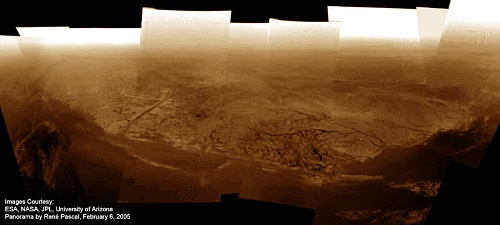
Image: Are there ways life could emerge on Titan? A panorama of the shoreline where Huygens touched down, stitched from DISR Side-Looking and Medium-Resolution Imager Raw Data. Image credit: ESA / NASA / JPL / University of Arizona / Rene Pascal (panorama).
Collaborating at Cornell with astronomer Jonathan Lunine and chemical engineer Paulette Clancy, Stevenson went to work on a cell membrane that could function in a cold and methane-rich environment. Clancy specializes in chemical molecular dynamics, while Lunine’s background includes working on the Cassini mission. With non-aqueous life on the table (Lunine had received a grant from the Templeton Foundation to study the possibilities), Clancy’s expertise seemed made to order. She comments on the work in this Cornell news release:
“We’re not biologists, and we’re not astronomers, but we had the right tools. Perhaps it helped, because we didn’t come in with any preconceptions about what should be in a membrane and what shouldn’t. We just worked with the compounds that we knew were there and asked, ‘If this was your palette, what can you make out of that?'”
It’s an interesting palette in a very interesting place. Liquid methane is the only liquid other than water that forms seas on the surface of a planetary body in the Solar System. The paper also notes the intriguing fact that there is an unknown process at work on Titan’s surface that consumes hydrogen, acetylene and ethane — these reach the surface out of the atmosphere but do not accumulate. Finding a cell membrane mechanism for Titan’s methane seas becomes an exercise in astrobiology that we can hope one day to weigh against data from the surface.
Using molecular simulation strategies given the challenges of cryogenic experimentation, the researchers screened for the best candidates for self assembly into membrane-like structures. The result: A cell membrane the researchers call an azotosome, made out of nitrogen, carbon and hydrogen molecules already known to exist in Titan’s frigid seas. If Earth life is built around the phospholipid bilayer membrane — water-based vesicles made from this are known as liposomes — then a methane-based membrane like the azotosome could be the Titanian analog, a flexible and stable cell membrane able to function at temperatures of -180 °C. From the paper:
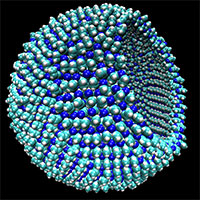
In a cold world without oxygen, we suggest that the vesicles needed for compartmentalization, a key requirement for life, would be very different to those found on Earth. Rather than long-chain nonpolar molecules that form the prototypical terrestrial membrane in aqueous solution, we find membranes that form in liquid methane at cryogenic temperatures do so from the attraction between polar heads of short-chain molecules that are rich in nitrogen. We have termed such a membrane an azotosome. We find that the flexibility of such membranes is roughly the same as those of membranes formed in aqueous solutions. Despite the huge difference in temperatures between cryogenic azotosomes and room temperature terrestrial liposomes, which would make almost any molecular structure rigid, they exhibit surprisingly and excitingly similar responses to mechanical stress.
Image: A representation of a 9-nanometer azotosome, about the size of a virus, with a piece of the membrane cut away to show the hollow interior. Credit: James Stevenson.
Could such membranes form on Saturn’s largest moon? We already know that a liquid organic compound called acrylonitrile can be found in the atmosphere there, and the researchers believe that an acrylonitrile azotosome compound would offer indigenous life the same kind of stability and flexibility that phospholipid membranes bring to life on Earth. Studying the metabolism and reproduction of the hypothesized cells is the next order of business, but Lunine talks of one day going well beyond theory to float a probe on Titan’s seas to sample its organics directly.
None of this demonstrates that life is present on Titan, but focusing on the availability of molecules that can form cell membranes helps us understand the kind of chemistries we need to look for under cryogenic conditions. In their conclusion, the authors talk about the ‘liquid methane habitable zone,’ a wonderful reminder of how our views on astrobiology are expanding.
The paper is Stevenson, Lunine & Clancy, “Membrane alternatives in worlds without oxygen: Creation of an azotosome,” Science Advances Vol. 1, No. 1 (27 February 2015), e1400067 (full text).

Were There Planets Inside Mercury’s Orbit?
With the Mercury Messenger mission now coming to its end, it seems an appropriate time to speculate on why our inner Solar System looks the way it does. After all, as we continue finding new solar systems, we’re discovering many multi-planet systems with planets — often more than one — closer to their star than Mercury is to ours. We have Kepler to thank for these discoveries, its data analyzed in a number of recent papers including one arguing that about 5 percent of all Kepler stars have systems with tightly packed inner planets. The awkward acronym for such systems is STIP.
Well, maybe it’s not all that awkward, and Kathryn Volk and Brett Gladman (University of British Columbia) have good cause to deploy it in their new paper, which focuses on this topic. They’re wondering why our Solar System lacks planets inside Mercury’s orbit, and they point to the paper I mentioned above (Lissauer et al, 2014) as well as another by Francois Fressin and colleagues that concludes that half of all Kepler stars have at least one planet in the mass range from 0.8 to 2 Earth masses with orbits inside Mercury’s distance from our Sun, which is 0.39 AU, or 58.5 million kilometers.
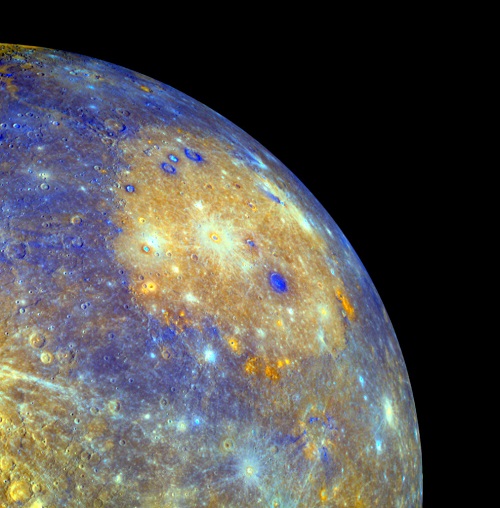
Image: The Caloris basin and adjacent regions on Mercury. Recent exoplanet discoveries raise the question of why our Solar System lacks planets inside Mercury’s orbit. Can instabilities in the early Solar System help us find the answer, while at the same time explaining some of the planet’s peculiarities? Image credit: JHU/APL.
Taking as an hypothesis that nearly all F, G and K-class stars originally form with planets well within Mercury’s orbital distance, Volk and Gladman ask whether the reason we find systems without such planets today is that instabilities have destroyed these worlds through generations of catastrophic collisions and gradual re-formation, leaving (in our case) Mercury as the surviving relic. It is true that STIPs can be dynamically stable over long time-frames (hence we see the Kepler examples), but the absence of tightly packed inner worlds around many stars is here taken as the result of a ‘metastable planetary arrangement’ that leaves one or no short period planets. The Kepler STIPs we see, then, are those that have survived this process.
The authors use the Kepler data to generate systems similar to those we have uncovered, allowing them to ‘evolve’ computationally to study system dynamics, taking some simulations well beyond the first collision to see how the instabilities multiply. An initial collision often produces second collisions at higher speeds. While low-speed impacts can occur in some systems, producing far smaller amounts of debris and subsequent accretion, a fraction of STIPs experience heavy perturbation that can lead to the destruction of their inner worlds. From the paper:
Our experiments show that instability timescales in these systems are distributed such that equal fractions of the systems go unstable (reach a first planetary collision) in each decade in time (Fig. 2). This logarithmic decay is not unknown in dynamical systems (eg., Holman & Wisdom (1993)) and is presumably related to chaotic diffusion and resonance sticking near the stability boundary. After a brief, relatively stable initial period, the systems hit instability at a rate of ?20% per time decade, with half of the systems still intact at ?100 Myr. The exact decay rate may be influenced by our usage of the current Kepler STIPs sample (perhaps the most stable); however if this decay rate held, at ?5 Gyr 5–10% of STIPs would not yet have reached an instability, in rough agreement with the observed STIPs frequency.
Turning the results on our own Solar System, they find that the orbits of the three outer terrestrial planets (Venus, Earth, Mars) remain unaffected on 500 million year timescales by the presence of additional planets totaling several Earth masses, all of the latter inside a distance of 0.5 AU from the Sun. Dynamical instabilities would have initiated a sequence of collisions among these worlds that left Mercury as the sole survivor. The authors argue that it is possible for the orbits of the outer terrestrial planets to remain unperturbed as the inner planets fall victim to these events.
Various issues are explained by this scenario. A series of collisions concentrates iron into the surviving remnants, which accounts for Mercury’s high density. The authors also ask whether instabilities in the inner system approximately 4 billion years ago could account for the Late Heavy Bombardment (sometimes called the ‘lunar cataclysm’), when Mercury, Venus, Earth and Mars experienced a high number of impacts. From the paper:
Gladman & Coffey (2009) estimated that 10–20% of large (m to 100 km) debris originating near current Mercury would strike Venus, with 1–4% impacting Earth (?0.1% strikes the Moon). The Earth’s impact rate would peak ?1–10 Myr after the event and decay on ?30 Myr timescales as Mercury and Venus absorb most of the debris; this is a plausible match for the cataclysm’s final stages (Cuk et al. 2010). A bottom-heavy size distribution for the 1–100 km debris could explain the recent finding (Minton et al. 2015) that a main-belt asteroid source would produce too many impact basins during the cataclysm.
Such an event might be studied by future sampling missions, for:
STIP debris would likely be mostly silicate-rich mantle material similar but not identical to main-belt asteroid compositions, consistent with cataclysm impactor compositions inferred via cosmochemical means (Joy et al. 2012). The smallest dust (being blown out hyperbolically) could impact the Earth-Moon system. We estimate that 10?11 of the departing dust would strike the Moon, at vimp ?30 km/s. If any dust or meteoroid projectiles were retained, fragments might be found in regolith breccias compacted during the cataclysm epoch.
This is an interesting model, and the authors point out that it gets us out of the difficulty of assuming an inner protoplanetary disk edge that has to be adjusted to account for Mercury and the lack of worlds interior to its orbit. We have a model that would leave the orbits of the existing terrestrial-class worlds unaffected by the series of collisions and disintegrations that Mercury emerged from, although the recipients of catastrophic amounts of early debris. The model also accounts for the apparent instability of Mercury’s orbit on a 5 to 10 billion year time-frame.
The paper is Volk and Gladman, “Consolidating and Crushing Exoplanets: Did it happen here?,” submitted to Astrophysical Journal Letters (preprint). Thanks to Andrew Tribick for the pointer to this paper.

Seeing Ceres: Then and Now
I’m interested in how we depict astronomical objects, a fascination dating back to a set of Mount Palomar photographs I bought at Adler Planetarium in Chicago when I was a boy. The prints were large and handsome, several of them finding a place on the walls of my room. I recall an image of Saturn that seemed glorious in those days before we actually had an orbiter around the place. The contrast between what we could see then and what we would soon see up close was exciting. I was convinced we were about to go to these worlds and learn their secrets. Then came Pioneer, and Voyager, and Cassini.
And, of course, Dawn. As we discover more and more about Ceres, the process repeats itself, as it will again when New Horizons reaches Pluto/Charon. Below is a page from a book called Picture Atlas of Our Universe, published in 1980 by the National Geographic. Larry Klaes forwarded several early images last week as a reminder of previous depictions of the main belt’s largest asteroid, or dwarf planet, or whatever we want to call it. Here the artwork isn’t all that far off the mark for Ceres, though Vesta would turn out to be a good deal less spherical than predicted. No mention of a possible Ceres ocean in the depictions of this time; all that would come later.

Image: Ceres and other asteroids as seen through the eyes of artist Davis Meltzer in 1980, with the Moon as a background.
The recent Dawn imagery has us buzzing about the two bright spots on Ceres that, of course, were unknown to our artist in 1980. From 46,000 kilometers, all we can do is admit how little we know, which is more or less what Andreas Nathues, lead investigator for the framing camera team at the Max Planck Institute for Solar System Research (Gottingen) does:
“The brightest spot continues to be too small to resolve with our camera, but despite its size it is brighter than anything else on Ceres. This is truly unexpected and still a mystery to us.”
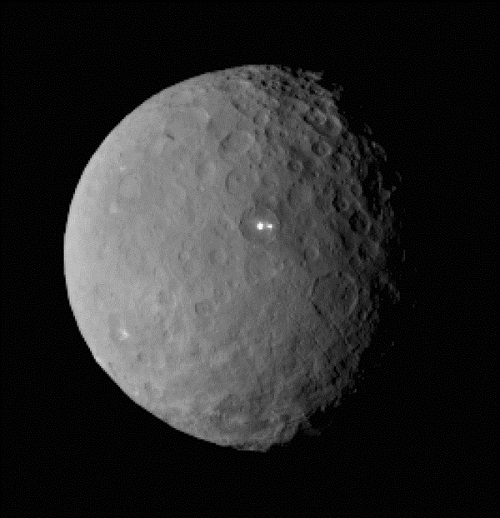
Image: This image was taken by NASA’s Dawn spacecraft of dwarf planet Ceres on Feb. 19 from a distance of nearly 46,000 kilometers. It shows that the brightest spot on Ceres has a dimmer companion, which apparently lies in the same basin. Credit: NASA/JPL-Caltech/UCLA/MPS/DLR/IDA.
Chris Russell, principal investigator for Dawn, speaks of a possible “volcano-like origin” of the two bright spots, but adds that we have to wait for better resolution to make any serious geological interpretations. The wait won’t be all that long (for better resolution, at least) given that we’re just days away from entering orbit on March 6. Could there be a better approach to this small world than this one, already focusing on something no one had expected to see?
In 1961, in an illustration from The Universe (New York: Morrow), we find Ceres again displayed with companion objects like Vesta and Pallas (I’m afraid I don’t know the name of the artist). Here the round, cratered Ceres is reasonably accurate, and you’ll note the size comparison, with Ceres tucked up inside Texas. At the bottom of the image is Eros, shown here as an object the size of Manhattan and described in the caption as “Flying end over end through space like an island torn from its moorings…”

And here is Eros as it appeared in the Astronomy Picture of the Day in 2001.

Image: Orbiting the Sun between Mars and Earth, asteroid 433 Eros was visited by the robot spacecraft NEAR-Shoemaker in February of 2000. High-resolution surface measurements made by NEAR’s Laser Rangefinder (NLR) have been combined into the above visualization based on the derived 3D model of the tumbling space rock. NEAR allowed scientists to discover that Eros is a single solid body, that its composition is nearly uniform, and that it formed during the early years of our Solar System. Credit: NEAR Project, NLR, JHUAPL, Goddard SVS, NASA.
When we get cameras in the vicinity of objects that for so long were just smudges in even the best telescopes, we sometimes find ourselves surprised and delighted, as witness the volcanoes of Io or, for that matter, the cryovolcanism and ‘canteloupe terrain’ on Neptune’s moon Triton. Sharpening the view takes us out of the realm of the artist’s imagination and into the world of concrete measurement. Giving up earlier visions can be poignant, as we learned with Mariner 4’s 1965 flyby of Mars, when a vegetative and even fertile Mars suddenly became a fantasy forever lost. But as Ceres is proving right now, the discovery of the unexpected is a much greater reward.

